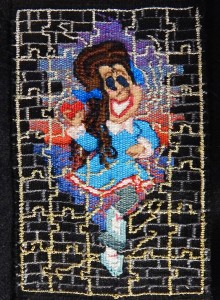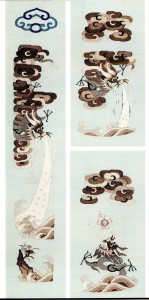Post 3-Choosing and choices-Beginnings and Endings
Choosing and choices-Beginnings and Endings
 This article contains my personal opinions about choices based on 37 years of weaving tapestries, teaching, repairing tapestries, observation, experimentation, and sharing techniques. Not everyone will agree with these opinions. Feel free to disagree and discuss. There are no tapestry police that will come and take your loom away from you, if you choose to do it your own way!
This article contains my personal opinions about choices based on 37 years of weaving tapestries, teaching, repairing tapestries, observation, experimentation, and sharing techniques. Not everyone will agree with these opinions. Feel free to disagree and discuss. There are no tapestry police that will come and take your loom away from you, if you choose to do it your own way!
Firstly, finishing a tapestry begins at the beginning not at the end of a tapestry. Not every way of finishing suits or should be used on all forms of tapestry. Needful things to be considered-before one should even begin to weave a tapestry:
Format- Consider-size, weight, shaped or not, double sided or not, direction of hanging, any size restrictions and if it is to be worn (garment, bag, etc.). It’s also important to determine where and how it will hang .
As a side note, the format is all about the size and shape of the piece and should be determined by the design itself-not chosen to be a certain size or weight by a past instructor or mentor. There are “no havta be”. It’s about what will make it work.
How will the tapestry be used? What special needs will this create for this one particular tapestry or for the purchaser and even one who purchases the item or the next owner? For example hand of the fabric, rug, movement of tapestry, utilitarian object or not, clothing, wall hanging, 3d, flat hairy etc. and etc. -ad infinitum. Will it hang on a wall, be walked on, worn as a garment, used as a bag or a purse? Must it be able to wear like iron or have a certain amount of fragility? 
3. Scale-The scale-size- of the materials. Scale determines how much detail you are able to achieve in a given a chosen format size. Generally, in any given format the smaller the scale the more detail one can achieve in a design or the converse the larger the scale in a given format the less detail that is possible. But, how much detail does one need at a given format? How much detail can you get in a given area? Again what is the feel or the hand you wish to achieve. How much time is there to weave the tapestry? Does it fit the budget of the piece-financially, time wise, deadlines- finishing restrictions-real or self-imposed? Scale can also help determine how it should be finished in the end. There are some things that are definitely different about small format and small scale tapestries such as no selvedge or turn under at all in small scale or shaped tapestries. Small scale can be more drapeable- even more wearable.)
4. Which loom will you use? Somewhere in this process in choosing what, how you weave and how you finish will be dictated by the loom choices you make. In finishing a tapestry you need to decide how much loom or warp waste you’ll need for the finish. Or, will the finished product be four sided, shaped etc. How much space and how much finishing length do you need for a given product? There is nothing more evil and discouraging then trying to braid or knot a tapestry without long enough ends to do the job.
5. “THE” WARP. (See Canons of Proportion Tapestry topics spring 2010 by KLTH. This is a great Tapestry Topic on proportion.) Different warps have different properties. Different warps demand different setts and often demand specific or different finishing techniques. Wool warps will have a tendency to retract and felt the weft to the warp a very good thing-unless you’re trying to do a pulled or shaped tapestry. Wool has more options in the way it is finished because of these properties. Ends on the back traditionally protected the tapestry back. In other traditions because of the felting qualities of the wool the ends can be graded in or clipped at the surface leave no ends. Examples: Turkish rugs, Navajo weaving and many SW weaver’s textiles.
Most linen, seine twine or dual duty warp is slicker-no hair or loft. It does not felt to the weft. Over time when hung with warps vertical or left unfinished the wefts can slide up and down the warps. Will the weight of the weft and the finishing hold the weft in place or pull out the finishing technique over time? Because of it’s nature, soumack is never a good choice for finishing a non-wool wool warp. Over time the weight and/or pressure of the weft can cause the soumack to not to hold the ends in place. If you feel you need to use soumack use a locking soumack and a braided edge to lock in place. You can also use a braided edge that can turn the wefts back and under. Or on a very large tapestry hung with the warps running vertically, a finely stitched machine stitch-not a serger or zigzag- because the selvedge edge can be stretched or shrunk across the width of the selvedge. Or, perhaps a more traditional knotted or macramé fringe at the bottom of the tapestry. Some tapestry weavers are actually contemplating a knotted macramé fringe. Of course, one can always weave as the Navajo do with four finished edges. There is a great article by Susan Maffei on
four sided textiles in the ATA Educational section.
Another thing to consider is the larger the warp structure, the bigger the rib can be and the further the distance between warps when you finish a piece. Can you live with it or need to make a less bold choice in the finishing? What is the look you are trying to achieve at the edge of the tapestry? Fold over selvedge, braided edge, smooth finished edge or dipped edge as the weft pushes out
 against the knot or braid? The larger the warp set the more likely the tapestry can unravel. In my small tapestries I prefer a very smooth edge-no selvedge. I twine and then braid the edges. On a large tapestry I do a selvedge, locked soumack and then braid the edge. The braid I use turns the warp ends back and under or into the selvedge so that when it’s turned the ends are hidden and protected by the selvedge or can be easily sewn to the back of the tapestry.
against the knot or braid? The larger the warp set the more likely the tapestry can unravel. In my small tapestries I prefer a very smooth edge-no selvedge. I twine and then braid the edges. On a large tapestry I do a selvedge, locked soumack and then braid the edge. The braid I use turns the warp ends back and under or into the selvedge so that when it’s turned the ends are hidden and protected by the selvedge or can be easily sewn to the back of the tapestry.6. THE WEFT. Choosing the weft to go with the warp or choosing the warp to go with the weft? Which comes first? The weft chosen can also determine what will be the most successful finishing method. But in a way, it doesn’t really matter because once you are in the finishing process, you still need to find a way to keep the weft stable on the warps. Finishing is about locking the weft into place. Choose a method that will keep it from spreading at both the top and the bottom. The slicker the warp, the greater the possible spread no matter what the format. Locking soumack is far better than line or dot soumack. BUT over time unless you’re using a wool warp soumack can spread if your ends are left too short. IT WILL unravel! Braiding on top of the soumack seems to stop that process and holds it in place. This is especially true in silk and sewing thread tapestries. Some are choosing to run a fine hand or machine sewing stitch along the last pass of the selvedge with these slicker materials. 4-finished edge tapestries will also not grow.
7. Selvedges-to have or not! There are many reasons to have selvedges and many reasons not to. Reasons for having a selvedge-protection of the edge and back of the tapestry; a place to hide the ends, for strength, a place for a seam. But, selvedges can also create problems-pulling and creating a smiley or frowny edge, rolling forward, making too much bulk. On mounted tapestries the bulk can allow the tapestry to slump back and create a ridge.
Things to remember about selvedges, they don’t have to be the colour of the warp.They can be weighted with drapery weights or rods. Selvedge passes should not be woven all the way from side to side to avoid the dreaded smiley or frowny pulled in selvedges edges when turned. Selvedges can have darts or slits woven into them to make shaping easier or lessen pulled in or out selvedges which is especially handy if you are
weaving for around cylinders such as in the case of clothing and bags. They can be woven of a lighter weft to reduce bulk. Selvedges can be turned under or not. Warp ends can be knotted and then needled
down through the selvedge. If you braid on top of a turned selvedge the braid can turn under the selvedge and with the ends protected inside. Selvedges can also have a very fine line of single sewing machine stitch on the outside edge when necessary or if the tapestry is to be given heavy use such as a garment or bag.
Selvedges need to be finished-with a crown braid, locking soumack, knotted, or warps needled in. No selvedge. Many small format weavers choose to not have selvedges-but the warp ends need to be finished in some way, braided or knotted, fringed or not.






